The technical riding challenge intensifies as Bruce Wilson’s expedition from Johannesburg to Cape Town with Trailquest enters its final stage…
The Dutch word Baviaanskloof translates roughly as the ‘valley of baboons’, but to us – on day five of our South African expedition on Triumph Tigers – it meant narrow gorges, tricky river crossings, steep mountain passes, and loads of technical riding. It was set to be a challenging 153-mile route that was 90% off-road. It was as if the trip had been turned on its head, with the unwelcome prospect of yet more relentlessly straight roads exchanged for visions of adventure, excitement and a step into the unknown.
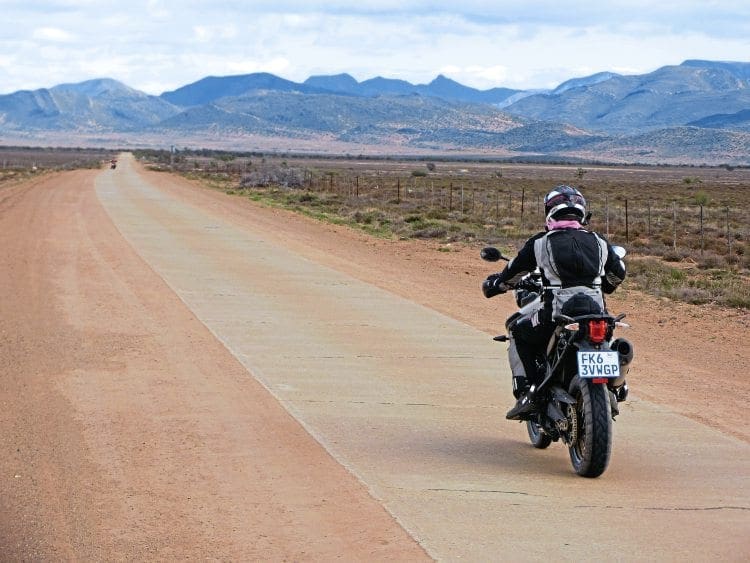
We were in for a long, hard day and that meant hitting the trail early and working our way south along a narrow, concrete road. Being only wide enough for one vehicle, it meant a detour onto surrounding dirt was needed each time we came across oncoming traffic, but thankfully we were pretty much the only travelers passing through. We were deep into the Karoo with only the occasional pen of sheep for company.
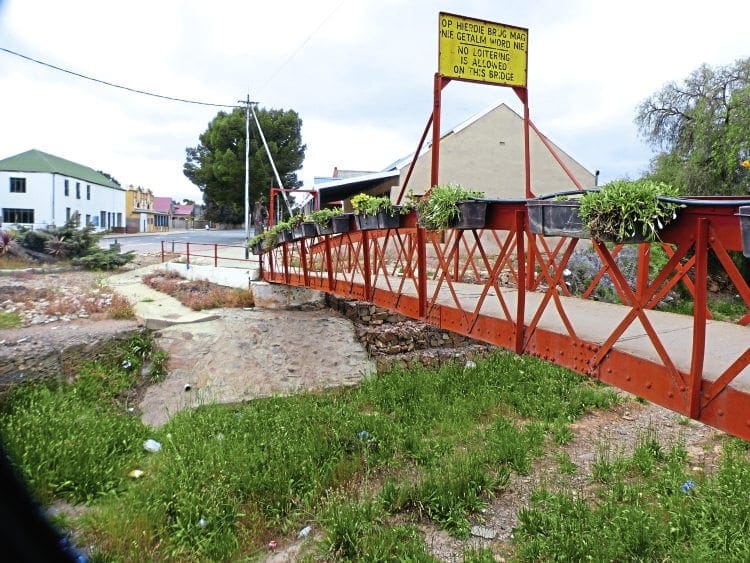
The air was cold and the odd drops of rain only made the ride to Willowmore drag that little bit more. When we got there it hit home instantly how lifeless the place was, with the attendants at the fuel station where we filled up being the only people visible. Where was everyone? Why were there no cars? Where did people go to shop? I never did find the answers as we were soon on our way again, edging closer to a route known as the R332. It turned out to be a dirt road that stretched away as far as the eye could see towards distant mountains. Being visitors, we had little idea of its significance, but as our Triumph Tigers’ wheels span, flinging clouds of dust in every direction, we had without realizing it just started out on an unforgettable journey.
Enjoy everything MSL by reading the monthly magazine, Subscribe here.
Those mountains that had once been so remote were soon all around us, bringing with them long sweeping bends and some amazing views from their summits. In the distance we could see the trail’s continued progress but no sign of its end, which must have terminated well beyond the horizon.
Around an hour into the journey we arrived at a junction where the team regrouped for a leg stretch. We were told this branch in the road was the last exit for 100 miles, which only added to the feeling of being deep into the wilderness. There was no city, town or village beyond this point. No petrol station, supermarket or hospital. We were on our own and that knowledge was both exciting and terrifying.
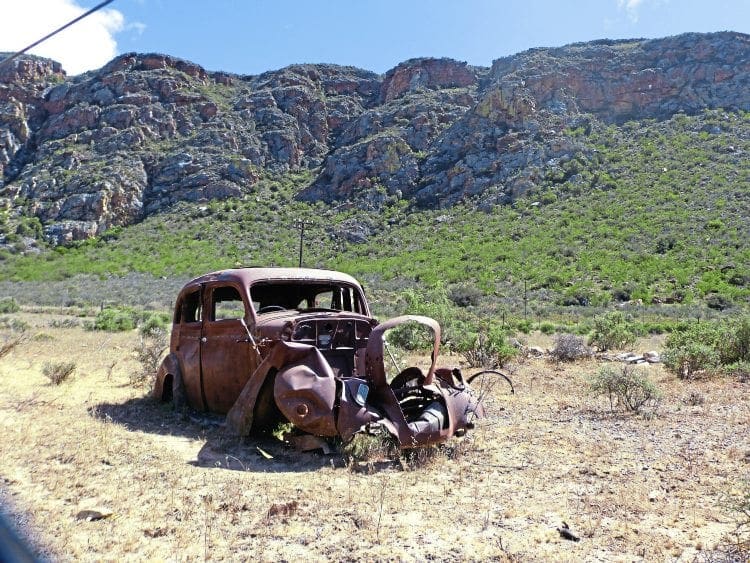
Back on the bikes, the next hour’s ride was even more stunning than the first, but nothing could compare to the day’s first bit of technical riding, which saw us descend into a sandstone gorge. The deep sand trail was surrounded on every side by towering rock faces, as rough and ragged as could be. We pulled up again to take in the magnificence of the landscape, which looked every bit the film set from an Indiana Jones movie. We could have stayed there all day, but the clock was ticking and it was soon time to get moving.
Leaving the gorge, we managed about three miles before one of the bikes got a puncture. I stayed behind in a small group while the rest went on ahead. By this point in the journey the support crew were super-quick at fixing tubes, but there was still time for me to do a bit of exploring of the surrounding area. It was midday, and the sun was at its hottest. In this rocky terrain that meant snakes were out to play, so I didn’t go wandering too far from the group. However, that didn’t stop me from clambering down into a warthog’s den, prompting a rollicking from our tour guide Arnold Olivier.
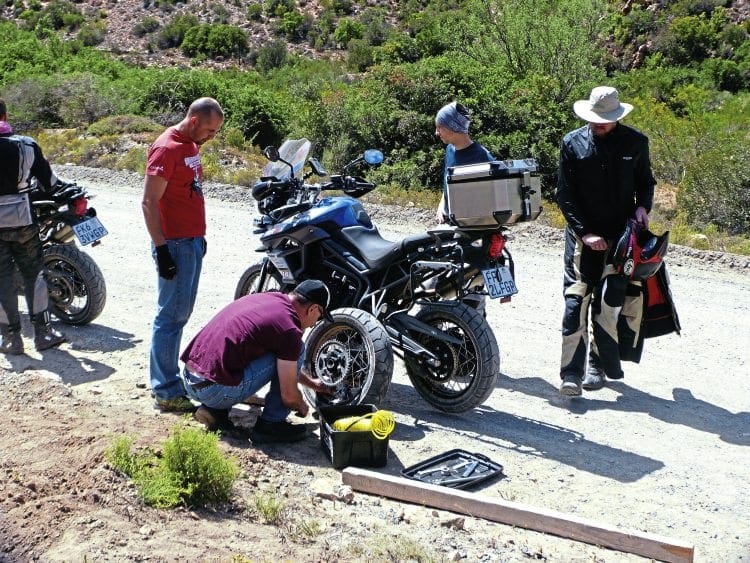
As the South African pointed out, we were a long way from help and the hog wouldn’t have thought twice about harpooning me with a tusk or two. Then there were the snakes, scorpions and spiders that shared its den to think about. I was out of the hole like a jack-in-the-box.
Three hours after joining the trail we arrived at a farm. The family who lived there were used to welcoming visitors to their B&B, which was where we were to stop for the night. Time was ticking, so we just about had time to throw down our bags and scoff a sandwich before kitting up once more and heading towards the Baviaanskloof Nature Reserve, where 20 ZAR (£1.25) gained us access to the World Heritage Site’s trail. Our guides gathered us to warn of the upcoming challenge, which was to make anything we’d come across so far seem like child’s play. This track was dangerous, technical and a long way from medical aid. We were offered the chance to turn back now, but no one chose that option. Following a few more words of encouragement from Trailquest CEO Richard Jeynes, the group started making its way into the back of beyond.
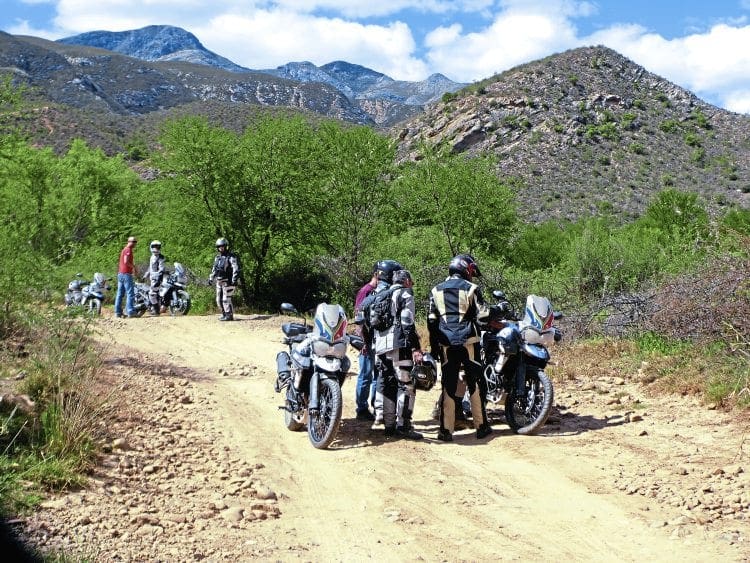
We’d gone just 20 minutes before there was a crash. Deep sand had caught us all out, but one of the group was unlucky enough to become the terrain’s first victim. It did quite a bit of damage to the bike, but thankfully the rider was okay. You could sense everyone’s nervousness, amplified by the limited time available to make a return journey along the intended three hour route. The guides encouraged those who felt confident to go on ahead, so I teamed up with Dean Miles and Trailquest’s Patrick Jeynes, and got cracking.
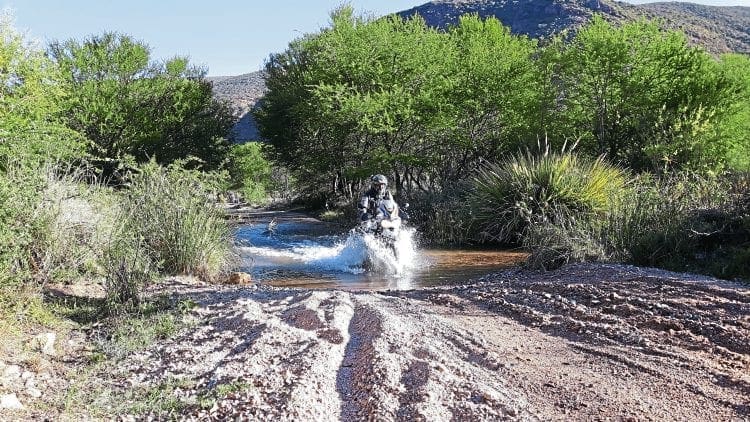
From the start, the riding was tough and the level of concentration required to master the diverse range of surfaces was painful, but it would have been a whole lot more painful to have made a mistake. From river crossings to sheer-sided drops of several thousand feet, and from huge craters to boulder fields that stretched off way into the distance – we had to tackle it all. Planning the best route ahead was essential, but reacting quickly to the bike’s behaviour as it hopped, kicked and skidded its way forward was even more crucial. The Tiger had proven to be an exemplary bike for touring, but now it was really being asked to be so much more than a comfy seat and heated grips. Luckily for us, there was never a moment where the bike let me down, even though I was doubting how it could possibly transform into the nimble enduro machine I wanted it to be.
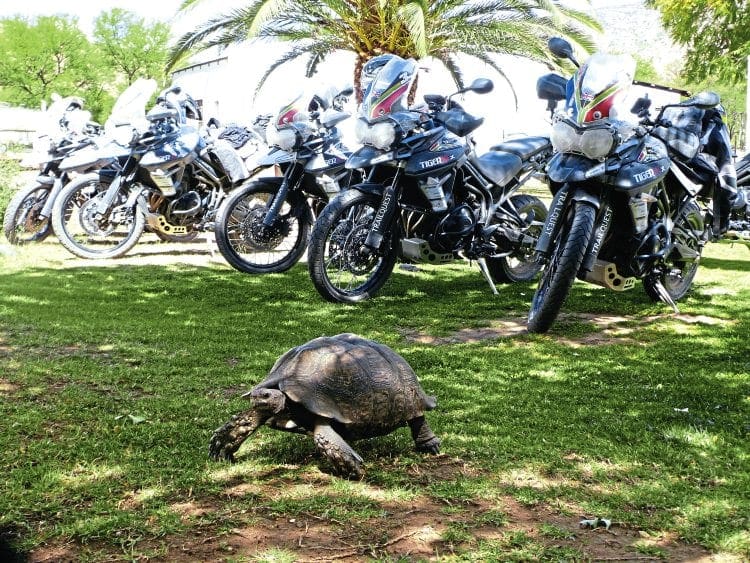
The heat was in the thirties and a well-earned stop was taken at the crest of the trail’s highest mountain. From there it was all downhill, which presented more of a challenge than those words might suggest. We were on 215kg bikes, fitted with road tyres and facing an extremely narrow, one-in-four descent of loose gravel, huge pot-holes and sudden death. If that sounds a little dramatic, it should do. It was bloody petrifying, yet exhilarating all at the same time. I lost count of every out-of-control moment that happened, but will never forget the feeling of relief that hit me when we made it to the end of the trail and arrived at the Smitskraal river crossing.
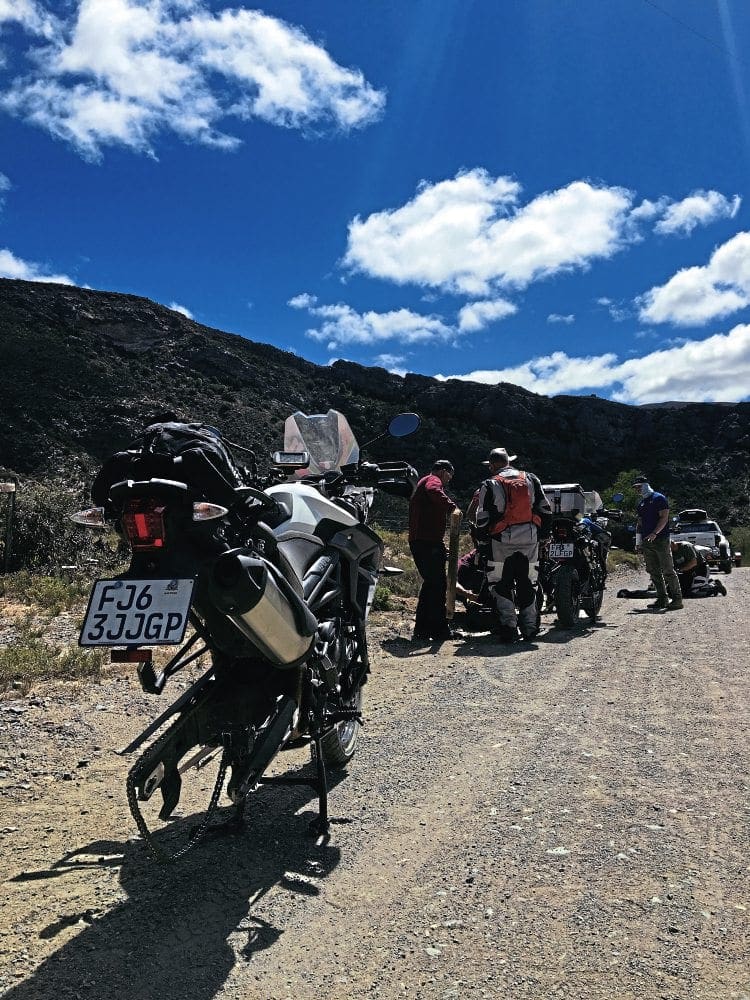
Our trio were soon met by Anthony Griffiths, Holger Schade and three other South Africans who were keen to cross the hundred metre river bed we could see before us. In for a penny, the whole group crossed the river for the sake of crossing it, only to have to return back and face its treachery once again. It wasn’t massively deep, but the loose stone bed was really slippery and made for a few funny scenes as limbs were fired off in all directions to keep the riders and bikes upright. It was a laugh, and the same can be said for the dip we took in the river to cool off and celebrate our journey. It was a shame the whole group hadn’t made it to the end, but we were thinking of them as we relaxed and recalled the ride’s highlights.
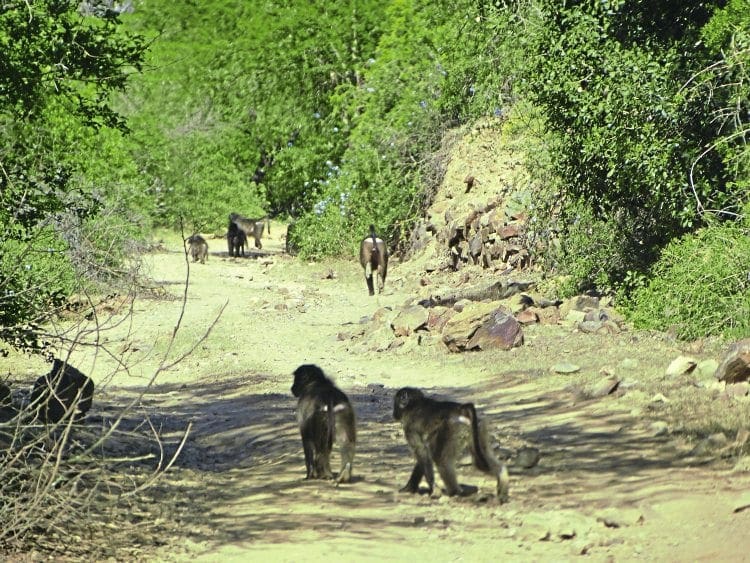
Having dried off as best we could, the return journey seemed so much easier. I guess we knew what to expect and had a good idea of how to face the challenges. But, just like any road, travelling a route in reverse throws up a whole world of different challenges, especially when it starts getting dark and animals begin appearing out of nowhere. Baboons were out in force; jumping from the surrounding shrubs and making you come to an abrupt stop. They might look cute, but behind their big smiles are menacing teeth, and their arms are stronger than Popeye’s. It was better to stop and let them vanish at their own pace than rush them and risk a kicking.
Klipspringers were another animal to take into account. The small antelope would appear, stare at us and then scarper up sheer rock faces; it was amazing to see. As the ride progressed, the biggest danger of all turned out to be shadows. The setting sun hindered our vision massively, blending huge holes into the darkness of shaded ground. The pressure of time had been with us all day, and now we were appreciating its importance first hand. We made it out of the national park just before sunset and cleared the 10km back to our night’s camp with relative ease. Over a braai and some beer, everyone had a story to tell that evening.
DAY SIX – UNSPOILED BEAUTY
When there’s only one way in, there can only be one way out. That meant we were treated to a return ride back across the awesome trail that had led us into the Baviaans the day before. Around an hour in we came across the trail’s first junction, which branched off to a town called Uniondale. To get there meant even more dirt roads, with these ones being the smoothest and best conditioned of the whole trip. The Triumphs were in their element as we blasted along at crazy speeds, sending dense dust clouds straight into the faces of those behind. It was so much fun, and I think everyone’s confidence had grown immensely having ridden and conquered the Baviaanskloof route the day before. Now these dirt trails, which had once given us the jitters, were little more than dusty roads to be ridden as fast as we liked.
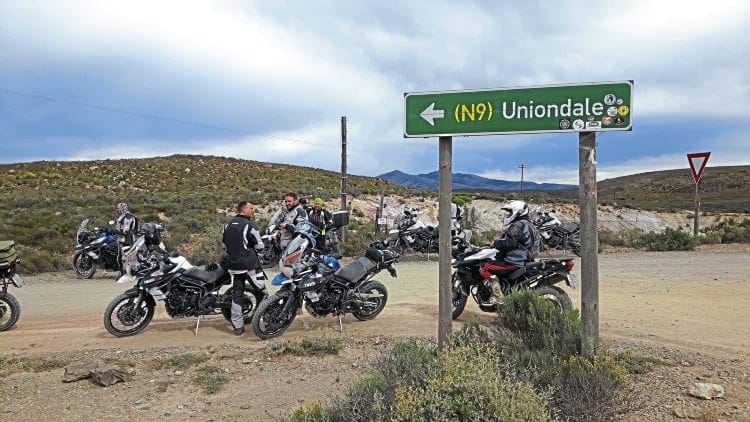
Uniondale was an interesting place. We fuelled up in the small town and were thanked by the assistant who explained that no one ever comes out their way. It was the same story wherever we went, which was a real shame. From a purely aesthetic point of view, we were travelling through some of the most stunning landscapes this earth has to offer – places that were overwhelmingly rich in beauty, but horrendously deprived of finance and commerce, as highlighted best by the township we passed on the way in to the settlement; people didn’t have much, and a natter with one of the locals taught me that jobs were just as rare as wealth.
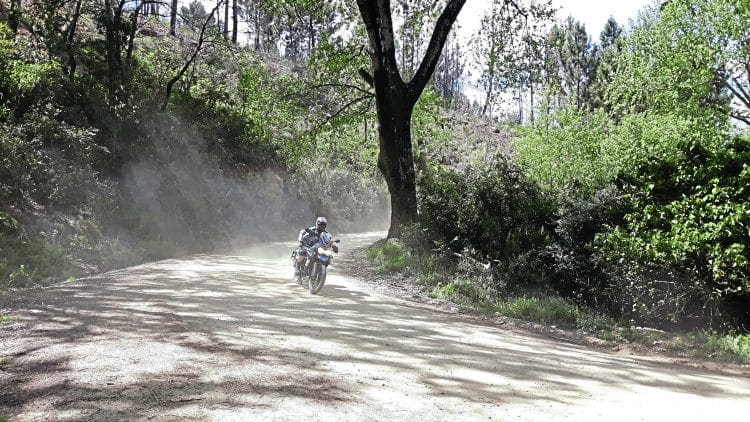
The Prince Alfred’s Pass between Uniondale and Knysna is arguably Scottish engineer Thomas Bain’s greatest work. He was the mastermind behind 29 different passes in South Africa, and this 68km route was the longest of all by a considerable margin. We took to the trail late that morning and within a mile it began to climb relentlessly, hugging tightly to the first of many mountains we were to navigate. The surface condition was remarkably good, and the views from the route were annoyingly breath-taking. Having stopped to take a picture, I’d only manage a few more metres before needing to pull up once more and whip the camera out again. It made for slow progress, but this pass deserved all the time we could offer it.
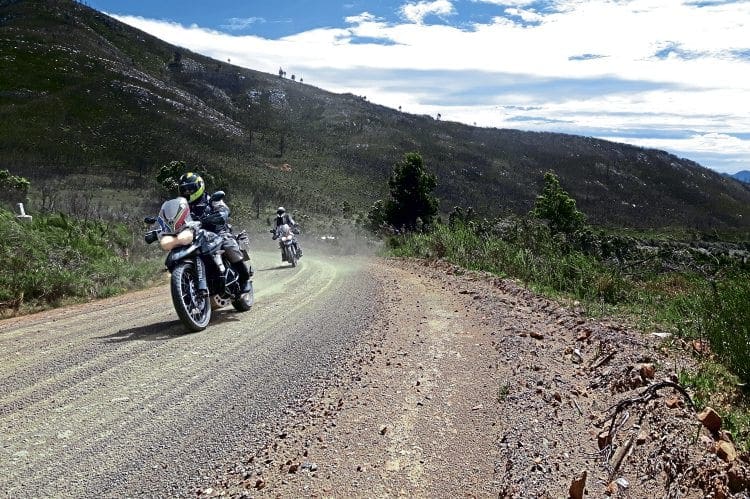
Around an hour into the ride we found ourselves exploring a hidden valley, pleasantly lost in the huge expanse of indigenous forest. Just as appealing was the flow of the trail, which never stopped twisting, rising or falling. Despite the surface’s good condition, the route was still plenty challenging. We were about an hour into the ride when the tour’s doctor Peter Gill took a tumble, falling just inches from a sheer-sided cliff edge. His Helite airbag had saved him from any serious damage, and his bike was also relatively untouched. It was a lucky outcome for both.
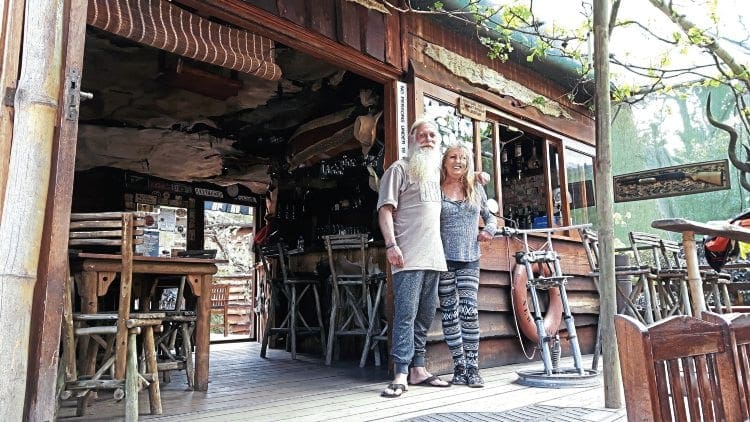
Soon after we arrived at the base of a valley, which was also home to a biker cafe called Angie’s G-Spot. It was rammed with weird and wonderful decorations, including everything from 10ft long anaconda skins to chairs made from old bike bits. The trail is a favourite of adventure riders, and the cafe was a popular stop-off. The fact it was the only place you could grab something to eat was irrelevant.
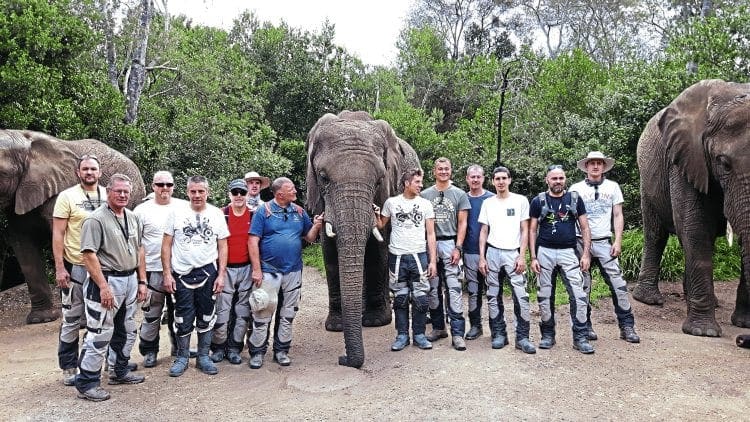
The rest of the trail was as varied and mesmerising, with the end eventually coming as we neared Plettenberg. It felt strange to be back on Tarmac again, which went to show how acclimatised we were becoming to riding the rough stuff. Thankfully, there wasn’t much road work left to do with the afternoon being consumed by a visit to an elephant park near Knysna, which was also the town at which we were to spend the night. The experience was fantastic and gave us the chance to not only feed the elephants, but walk them by their trunks too. It might sound strange but it actually felt quite natural and topped off a day that had been pretty exceptional.
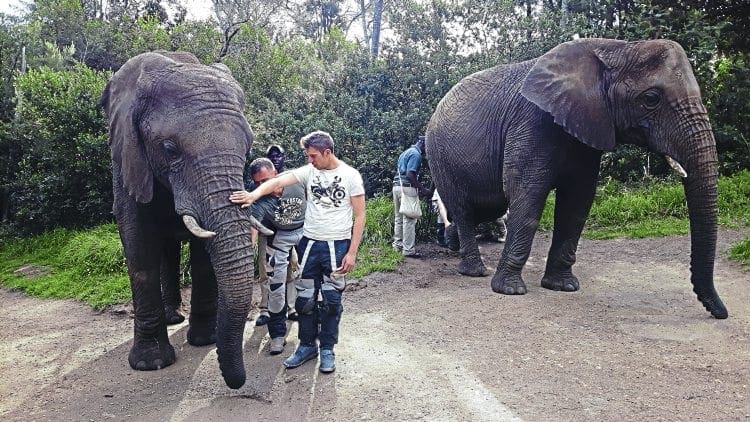
DAY SEVEN – THE HELL
The 5.20am alarm meant it was time to get up and ride out to the top of the nearby Kynsna Heads. This clifftop position overlooked the point at which the Indian Ocean met the Knysna lagoon, making for the perfect location to watch the sun rise. From there the group started making its way towards a route known as the Seven Passes. As the name suggests, this section of trail consisted of seven individual passes that meandered their way inland to the mountainous town of George.
Within a matter of miles of joining it, the Tarmac morphed into mud and the street lamps were replaced by towering trees. We were remote once more and soon destined to travel through seven spectacular gorges and cross 10 rivers on the 47 mile trail ahead. Punctures were now a regular occurrence, and it only took around 12 miles before a bike had fallen foul of a rusty nail. While the guys from the support crew got stuck in to fixing the problem, the rest of the group kicked back, sipping cool drinks at a nearby secluded roadside bar. We were probably their only customers that day – maybe even that week – which is possibly why they were so warm to our tribe of motorcyclists. It fuelled us for the rest of the ride, which eventually brought us to the suburbs of George.
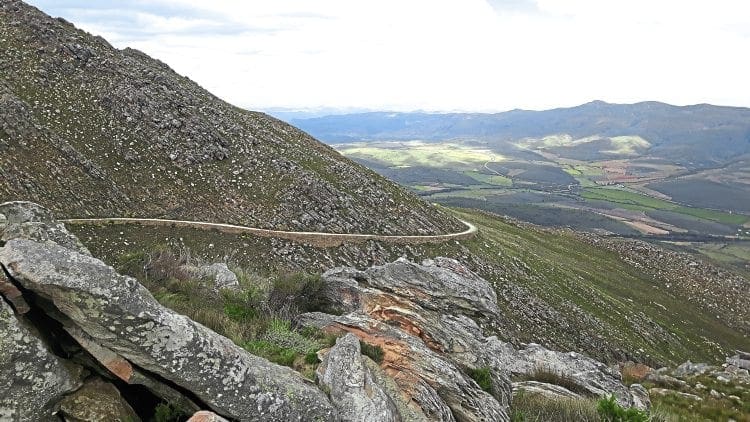
We’d been travelling in South Africa for a long time now, seeing a whole variety of settlements, but George stood out as being the most westernised of all. It was full of attractive houses and well-maintained gardens, and was also full of the typical schools, libraries and shops you’d expect to see back home. It was pleasantly familiar as long as you disregarded the surrounding mountains. Nestled within them was the R12 carriageway, which would lead us north towards Oudtshoorn and the place of our well-earned lunch. The route turned out to be a stunningly winding Tarmac mountain pass, but the most mind-blowing thing of all was the transition in scenery as we crested the pass and began to descend the far side. We were now in the Small Karoo, the lush forests of George lost to huge flatlands and farmed plains. As well as the change in topography, the temperature altered dramatically as well. It was almost 10°C warmer, which no one complained about.
In the early afternoon we arrived at a route called the Swartberg pass – Thomas Bain’s final engineering feat, and a national monument. It was a sheer-sided trail that led out to a town called Prince Albert. We’d already had a great day of off-road, but this route took things to a whole new level, quite literally. Before we knew it we’d climbed sky high on the warped pass, which offered nothing in the way of protection to stop us riding straight over its sheer-sided edge. The height was staggering, but so too were the views.
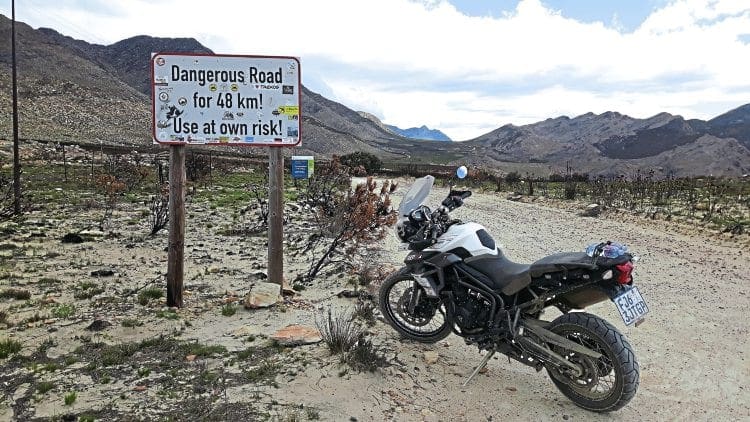
After a quick breather at the summit, the ride continued and eventually brought us to a junction where we joined a narrow spur of a track. At the mouth of this new route was a warning of danger for the next 30 miles…
This was the route to Gamkaskloof, which was more commonly known as ‘Die Hel’ – ‘The Hell’. It contained 201 bends, climbed a total of 1049m and descended 1854m over a series of small and big passes. At the end of the tough-going trail was the Gamkaskloof valley, which had first been inhabited by wandering Boer farmers who’d accidentally discovered the fertile lands in the early 1830s.
For over 120 years the villagers lived in isolation in the valley, being totally self-sufficient. With the building of a nearby dam in the 1950s the government built a primitive road into the valley in 1962. As the inhabitants packed up and left, the area was claimed by local officials and declared a World Heritage Site in 1997. The area’s impressive heritage was mirrored only by its long, technical and edgy access route, which vanished off into the distance. The tricky road caused a few crashes on the ride in, not helping people’s confidence when they eventually faced the challenge of a huge descent of tight switchbacks into the valley below. The ride took around two hours but it was worth it and I was relieved to have made it unscathed. We all had phones, but there was no signal to call for help, and little chance of getting an ambulance out to our location. We were well and truly on our own once more, which felt edgily exciting.
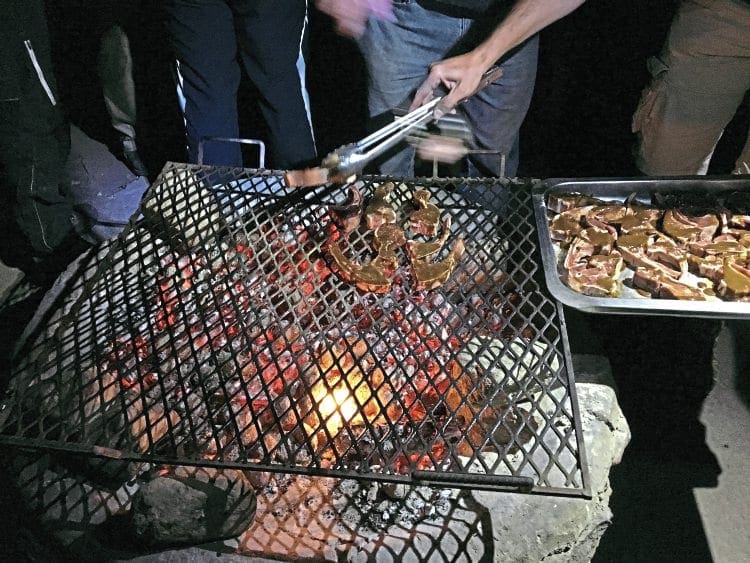
Through the centre of the valley was a withered trail that stretched out for five miles, lined sporadically with remnants of the original inhabitants’ primitive homes, renovated by the government. Having paired up with Jan Svoboda, Pietro Rinaldo and Francesco Ragazzi, we’d been allocated a place on the outskirts of the camp. It was creepy-looking, with a tin roof, no mains electric and an old range stove in its kitchen area.
It had been the home of a villager called Grandpa Pete, whose eyes stared harshly out at us from the black and white photos littering his house. We were all a little freaked out by the images, and equally by the likelihood of there being spiders, snakes and scorpions nestled in the bamboo roof.
Having completed a thorough search, we made our way up the road to where the main group had just got a braai going. As darkness set in we were treated to an amazing show of stars in the non-light-polluted sky, and even got to witness a satellite shooting past at an unbelievable speed.
Life was very good and it was made better when support driver and Nay-World CEO Roan Rossouw offered to drive us back the 500m to our home, eliminating the chances of coming across a baboon or leopard in the process. It’d been a very long day and, although very different from our ride into the Baviaans, was equally memorable.
DAY EIGHT – NOT OUT OF THE WOODS
Waking up in ‘Die Hel’ was an experience like no other. I’d had a really restless night and found myself feeling as if I were trapped. I’m not sure where the panicky feeling came from, but it made me keen to kit up and get the hell out of there when daylight arrived. A few of the others felt the same, unable to put their fingers on why they felt so uneasy.
Others were perfectly content and welcomed the additional time we spent in the valley visiting the site’s museum. Here we learned all about the area’s history, its people and the eventual demise of its settlement. It made for interesting reading, but I was so keen to get gone that I didn’t really take it all in. Others saw the visit as a distraction from their fears of climbing back out of the valley on the treacherous switchback route.
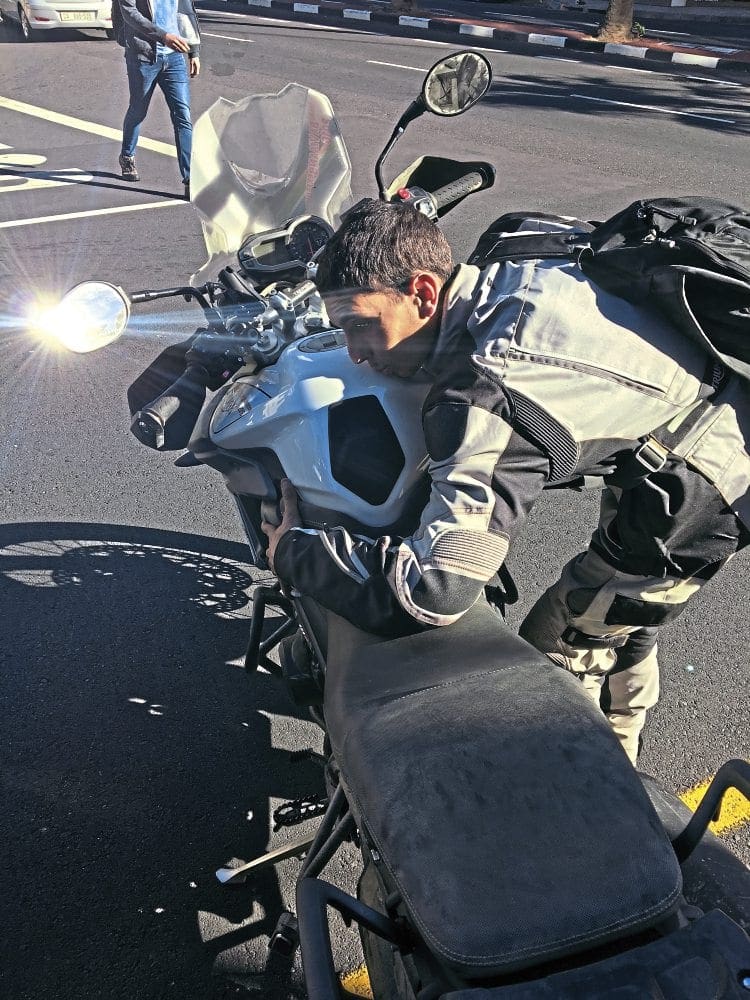
Before attempting it, our lead rider Arnold Olivier pulled me and a few others aside to share a bit of his wisdom and crank up our confidence. It did us all the world of good and I felt really confident as I slotted in immediately behind him on the climb, just following his lines from a distance all the way to the top. There were no harrowing moments, but the relief was overwhelming when we eventually reached the summit and looked out over the 30 miles of trail that kept us the wrong side of civilisation.
Of course, we were still a long way from being out of the woods with countless river crossings, stone beds and hairpins to take in. Then there was the deep sand, severely rutted ground and abundance of boulders to negotiate. It was hard going for us all, with a constant urge to look behind in one’s mirror to make sure the following riders were safe.
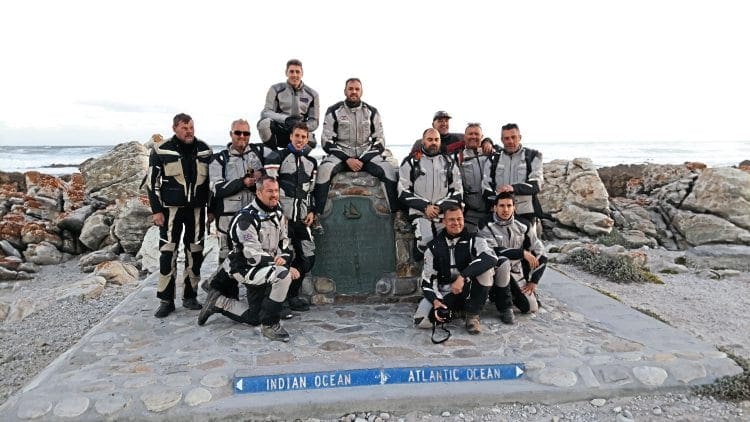
Unfortunately, there came a point when the three guys behind me vanished out of sight. The group had already had two accidents since entering ‘Die Hel’ and now we’d just experienced our third. Thankfully, the rider in question was fine and the hardy Triumph he was riding was still workable. We regrouped and cracked on, making it safely to the Swartberg Pass a few hours later. The relief was indescribable, along with the pride of knowing that we’d all been to hell and back without any serious incidents. Considering the inexperience of some of the riders in the group, that reality was testimony to the hard work and constant guidance from our tour guides and organisers.
Dirt roads led us south, with Cape Agulhas being the night’s destination. It’s the southernmost point of Africa and claimed to be where the Indian Ocean meets the Atlantic. From our location in the Small Karoo, it meant a long hard ride of several hundred miles.
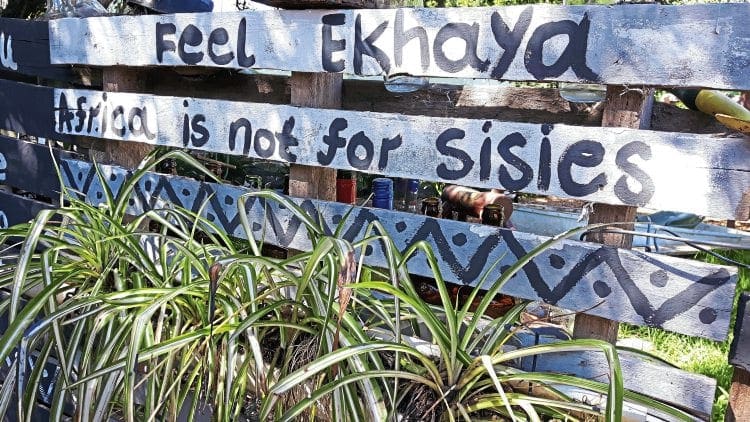
Dead straight and set among rocky desert, Route 62 was to be our major road south. It was a historic length of Tarmac much akin to America’s Route 66, having been the main transit route for migrating workers over several decades. We passed the occasional village along the way, but there was otherwise nothing more than rocks and sunburnt shrubs to take in.
A welcome break from the monotony was Ronnie’s Sex Shop. It’s said that the remote café was struggling for business, but things changed when someone decided to graffiti the word ‘sex’ onto the building’s wall. It was now a major tourist attraction, which seemed odd considering the most exciting things on its menu were a milkshake and Caesar salad. Still, refreshments were very welcome, and so was a leg stretch.
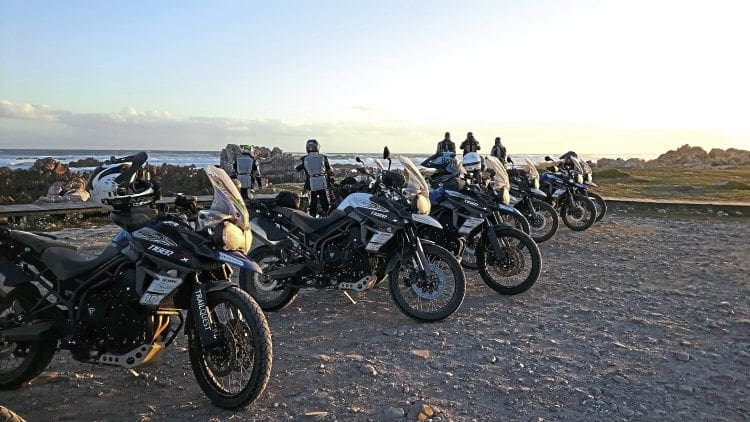
After too many hours on the R62 we finally branched off and found ourselves on the stunning Tradouw Pass. Just like the pass that had led us in from George, there was a distinctive change in habitat and temperature as we traded the barren Karoo for the greenery of the Western Cape. By this point we were all flagging a little and the arrival of a harsh, cold wind didn’t make life any more pleasant.
We still had 60 miles to go to reach the Agulhas, and there was less than an hour until sunset. We were all tired, but hard work from the entire group saw us arrive at the location just in time to watch the sun go down. It was a momentous occasion, rounding off one of the toughest and longest days of the trip.
DAY NINE – RETURN TO NORMALITY
Today was our last day. Somehow we’d reached the end point of our adventure, with the final ride being a straightforward 185 mile run in to Cape Town. There was no more dirt, no more wilderness, no more ‘where the hell are we?’ moments. For the first time in nine days, life returned to something approaching normality as we straddled our bikes and took the coastal road toward the whale-birthing town of Hermanus. Unfortunately, we didn’t get to see any of the majestic animals out at sea, but took pleasure in watching waves crash against the rocky shore. Having spent so many days in arid, forgotten territory, the rich colours of the sea and the scent of the coast seemed mesmerising. We could have stayed all day, but there was riding to be done. The land surrounding us looked European, with lush green pastures farmed much the same as they are back home. Villages were plentiful and the roads we travelled were smooth and well maintained. It was hard to defy the urge to go ‘off-piste’ and ride the dirt trails we could see in the distance. Instead, we hugged the coastline as much as possible until mountains crossed our paths once more.
We climbed up high before descending into Rooi-Els and picking up the stunning Clarence Drive route. It was a fantastic stretch of Tarmac, which hugged the coast and continually altered in altitude, all the way to Gordon’s Bay where we stopped for a quick lunch. As ever, we had a tight schedule to meet with a celebratory photograph planned on reaching Cape Town, at the V&A Waterfront.
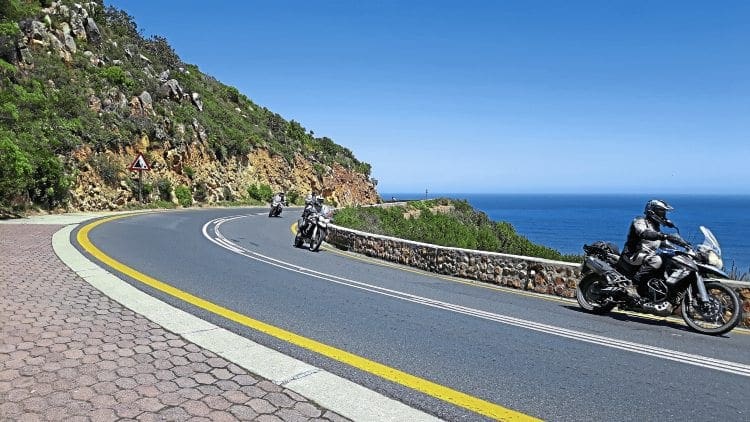
There was a sense of achievement on reaching Cape Town’s perimeter signs, but the joy was robbed by the realisation that our ride was soon to come to an end. It was crazy to think on where we’d been in that time, who we’d met and how the team had bonded as friends. We were a gang of our own and I’m sure everyone’s thoughts were the same as we stared into the camera’s lens for that one last team photo. We’d have given up food, comfy beds, beer and all the other luxuries we’d been craving for just one more stretch of trail. But that wasn’t to be.
Instead, we made our way through the busy city’s streets to a local Triumph dealership where our bikes were lined up for the last time. There were happy faces and handshakes all round as reality hit home that this journey had come to an end.
For me, this had been an adventure of a lifetime; a chance to see a part of this world I didn’t know existed – a chance to face new challenges and to make new friends and memories that will undoubtedly live on forever. Just like all those who’d been through the experience with me, I’d lived my dream and loved every moment of it. South Africa, you were amazing.
Helite TT Airvest
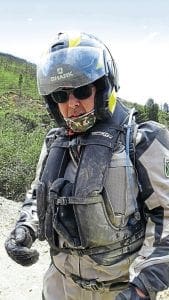
There are a few different types of airbags on the market, with Helite’s being a mechanically actuated system, triggered via a sharp tug on a lanyard inking the rider to the bike. To be honest, I’d never worn an air-vest before the South Africa expedition, so I was a little unsure of what to expect.
It wasn’t until one of the group had a bad crash and ended up in hospital that I dug out my Helite – which had been supplied to the group by Love Life and Ride in Thames Valley – and started wearing it. It fitted over the top of my Triumph riding gear with ease, and after a few miles I’d forgotten it was there.
What took a bit more getting used to was the clipping and unclipping of the lanyard. Thankfully, the system needed a serious amount of weight to trigger the bag, so I avoided any undesired engagements of the system on the countless occasions I hopped off my Tiger without unclipping. In fact, I avoided setting mine off across the entire trip, but saw a few people activate theirs during crashes. No matter how severe the incident, all of those who went down avoided serious injury, which was testimony to the vests’ performance. Each time the system was fired, the suit would expand with CO2 from a pressurised cylinder before the rider hit the deck, then deflating over the next few minutes.
It took no time to recharge the jacket with a new cylinder, costing the wearer a few pounds to replace the exhausted cylinder. On the last day of the trip I lent my jacket to one of the others in our group and suddenly felt vulnerable. I’d seen the value in the vest and wouldn’t hesitate in recommending it to any motorcyclist, regardless of whether they’re tackling the everyday commute or extreme trails in deepest, darkest Africa.
For more info and prices, contact Love Life and Ride on 0118 328 0338 or visit www.lovelifeandride.com.
Mission accomplished – Richard Jeynes, Traiquest CEO
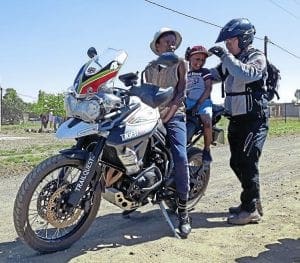 On completing the adventure, organiser Trailquest’s top man Richard Jeynes gave his take on what makes for a great expedition and how he thought the Trans Baviaans trip had gone.
On completing the adventure, organiser Trailquest’s top man Richard Jeynes gave his take on what makes for a great expedition and how he thought the Trans Baviaans trip had gone.
“From time to time a project comes together where everything works smoothly and the end result is better than expected. The Trans Baviaans expedition was one of those,” he said.
“The very nature of adventure expeditions normally means that one can expect things to go wrong at some point, but careful preparation and planning can go a long way to insure against this. There’s no doubt that the time spent selecting, training and preparing the team that took part was a vital factor in the overall success. The old saying that time spent planning is seldom wasted is very true, and while you can never plan for every eventuality you can prepare a team to deal with the unexpected.
“Pre-expedition training enables teams to get to know each other’s strengths and weaknesses, and bond together in a way that creates real friendship and an ability to tackle whatever happens. With good team spirit, clear and firm leadership, a reliable support team and a willingness to support one another, the Trans Baviaans team was able to tacke a challenging adventure, overcome all obstacles and create memories and friendships that will last forever.”
Things to do in Cape Town…
Cape Town is a tourist’s dream. The historic city, which was originally inhabited by the Dutch East India Company in 1652, is rife with things to do, whether you want excitement, culture or relaxation. One huge appeal is the shark diving experiences that take place a short drive away in Gansbaai. Here you’ll have a chance to come face-to-face with Great White sharks from the safety of a submerged steel cage. Expect to pay around £50 for a three-hour voyage, which will typically include snacks and drinks.
For the less outgoing, a side-car adventure around the Cape peninsular is another must. Cape Sidecar Adventures has a fleet of three-wheelers that are ridden by local guides who’ll offer a number of popular tours to suit your budget and free time.
Helicopter flights are available from the sea front, with the 45-minute Twelve Apostles tour being particularly fantastic. You’ll have the opportunity to see the entirety of the Mother City and its surrounding suburbs from a whole different perspective. Of course, the other option for a great overview is to climb Table Mountain. The iconic peak can be accessed via a number of different walking options, a dedicated tourist bus, or even the cable car that takes you right up to the summit.
But for those who really want to get a feel for the local culture, nothing beats a good walk around the city’s streets, which are crammed with fantastic eateries, historic buildings and live music venues.
Fancy riding a tour like this?
Find out more by contacting the Trailquest team on 01531 650252, or via www.trailquestadventure.com
Words & photography: Bruce Wilson






